#which usagi is that referring to? depends on who you ask
Explore tagged Tumblr posts
Text
Self-proclaimed eldest of the girls:
Itsumi!
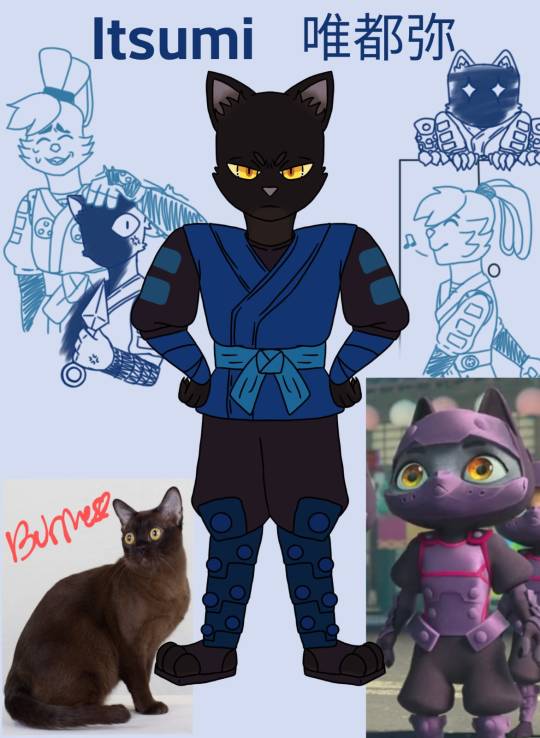
CLICK FOR BETTER QUALITY
Lmao look at that pic of a Burmese I used as reference and then the canon image, tell me they are not the same i dare you(joking)
She is SO *clenches fist* I'd be shaking her if she wouldn't stab me
Her relationship with Yuichi is very much one of those siblings, "only I'm allowed to call you shit, anyone else does I'm throwing hands." Except it's usually very sharp and deadly objects in this case.
Lovingly bullies Yuichi. Auntie very much had to do the whole domesticating a feral kitten for all the ninja but especially with her.
If they had phones and a groupchat vvv
Yuichi: -hey Gen how do you quell a sisters murderous rage?
Gen: -What.
Yuichi: -time sensitive question Itsumi's trying to kill Lord Kogane
Chizu: -Let her.
Kitsune: -let her!!!!
Kiyoko: -13t h3r 1m40
Toshiko: -Let her lol
Gen: -....
Yuichi: -GUYS
Gen: -Yeah, okay.
Gen: -Let her.
Copy and pasting my rambles from notes app:
Itsumi is sooo fun. She thinks Yuichi is an idiot and is frankly astonished he's still alive and that he's lived so long(she admires him, his kindness and determination). She tolerates him as he loves and cares for all the neko ninja orphans as little sisters (he loves and cares for her). Just. She was snarky and bossy and disbelieving. And it could have just been she was a brat kid and/or a bully. Or. Or It could be that she was always trying to be the loudest among them, speaking up and speaking out to get all the attention on her, "Look at me, look only at me, pay attention to me, ignore them, leave the others alone, they are not worth your time, focus on me." And disbelieving how Hanna actually got out of the crew because she needs to nip false hope in the bud to avoid getting hurt. Because while the other kittens sometimes have a confused or concerned expression, she had an angry or sceptical one. And she was always in front while the others were at her side and a step behind. She needs to be on the lookout, she needs to guide and protect the others because who else will? And Yuichi got them out. Sure Chizu and the others helped but Yuichi gave them a home. Tells them the best napping spots. Will tell them to try and find his hidden comics on their own, but will give hints(that aren't so much so hints but their exact locations) if he feels like they might be struggling even though they very much are definitely not. Pats their heads. Calls them imouto. Lends them his old clothes, gives them his childhood toys. Became their big brother. Goofy and more childish than them sometimes, but a good and caring older brother nonetheless.
Going from living with Lady Fuwa to living with Auntie on the farm.... They were always kept in the dojo, and depending on how young they were taken in never even remembered or knew what the sky looks like, and then its shown in the show that because of the bright lights of Neo Edo you can't see the stars, and then their first night at the farm, still disbelieving that they're truly free, together in a room because there's no way they feel comfortable enough to separate, and then looking out a window and seeing a sky, blue, dark, and covered in stars.
Itsumi chose new clothes that were blue, and yes it was to copy Yuichi (she will forever deny that) but also because blue is the color of freedom, the color of the samurai who held out his hand and tried to teach them to be good, the color of the sky overhead as you realize you are free to rest your head and not worry about a demon in red coming for you and your sisters family comrades, just. Peace.
She'll never admit that though, it's more tactical now, she'll say. The blue blends in better with the night sky now that the lights are off.
#samurai rabbit: the usagi chronicles#samurai rabbit the usagi chronicles#samurai rabbit#the usagi chronicles#usagi chronicles#srtuc#sr:tuc#srtuc neko ninja#srtuc neko ninja crew#neko ninja#neko ninja crew#srtuc itsumi#i spent way too fuckin long trying to find a fake textchat maker#gave up#the group chat would b called Usagi Protection Squad (derogatory)#which usagi is that referring to? depends on who you ask#long post#ish#better safe than sorry#Itsumis also like a foil(?) to Norie a parallel(?) one of those two
9 notes
·
View notes
Text
An Informal Guide to Writing about School in Japan
Sorry for posting this so late! Thank you for your patience.
This post should be used as a general reference for when you're writing something that takes place in a Japanese school. I made this because there have been a few stories (and even real articles!) written by people who seem pretty... uninformed about how Japanese schools actually work, but please use this as a framework for your story rather than a complete Bible.
Note: This post is informed by two things - my experience working at Japanese public schools, and being an American. The things I include in this post will be things that stand out to me as someone from the states. That being said, Japanese and American schools operate very differently, so there will be a lot!
A Year Overview
1st semester begins in April, and ends right before summer break in June. 2nd semester begins in late July or August, and ends before winter break in December. 3rd semester begins in January and ends in late March.
There is a very short spring break between 3rd semester and the entrance ceremony in which teachers/staff are told if they will be moving to a new school or not. This is specific to public schools. Academies/private schools likely don't adhere to this exact rule since they're contracted for a certain amount of time.
Grades and Classes
In large schools, each grade is divided by class. Each class has about 25+ students in it depending on the size of the school. In elementary school, junior high school, and high school, classes are either divided by letter or number.
For example, if you are a JHS 2nd year in the 1st class, you will be in 2-1. If you are an ES 5th grader in the B class, you will be in 5-B.
Kindergartens and daycares divide classes differently, and are called things like "Rabbits" or "Lions" - I'm pretty sure the names are ways to separate the ages. For example, the "Lion" class is the oldest (5-6 years old) and the "Chick" class is the youngest (1-2 years or less).
The word for "class" in Japanese is 組 ("kumi"). When referring to a certain class, we usually just say - using the same examples as above - ichi-kumi (Class 1), B-kumi (Class B), usagi-kumi (Rabbits)
Ages and Years
Elementary school - 1st grade through 6th grade (Ages 7 to 12)
Junior high school - 1st year through 3rd year (in the states, we would call it 7th through 9th grade. Here, they say JHS 1st year, 2nd year, 3rd year) (Ages 12 to 15)
High school - 1st year through 3rd year (same note as above, 10th through 12th grade) (Ages 15 to 18)
Homerooms
As stated above, each grade is split up into sections, called homeroom classes. In JHS and HS, a teacher will be in charge of one homeroom class as well as one main subject. Not all teachers have their own classrooms (depending on the size of the school, sometimes you have more subjects to teach than students!) but most of them do. However, that doesn't mean there is a dedicated "math room" or "English room" - instead, teachers will move to different classes, and students stay in their homeroom. In elementary school, your homeroom teacher will typically teach every subject. Of course, there is a teacher per subject per year. For example, if you're in a mid-sized junior high school, there would be 3 English teachers.
Between classes, students have a 10 minute break or so. This is so students can use the restroom and drink water (they can't do it during class) as well as prepare their materials for the incoming teacher. Class leaders will also go to the teacher's office and will sometimes be tasked with carrying materials to class or preparing something separately (like turning on the projector, the TV, getting white boards, etc.)
School Subjects
Besides the core subjects (English, social studies, math, science, Japanese, P.E.), Japanese schools also have calligraphy and home economics.
Homeroom teachers will also be asked to teach sougo (interdisciplinary studies) and moral education. I believe sougo is a fairly new subject that was added to Japanese curriculum a little over 20 years ago - from my understanding it's kind of like a psychology, economics, and sociology class all wrapped up into one. Moral education, on the other hand, has been described as "very Japanese" by all of my coworkers - it's like a "here's how we follow the rules", "here's how to be polite", "here's why having good behavior is beneficial for everyone" type of class.
Japanese schools also do not offer advanced classes. All students are expected to take the same class unless they have been put in the special needs classes for learning disabilities, mental health problems, or behavioral issues. Special needs classes tend to be taught at a lower level and sometimes a mix of grades as well. Special needs students "belong" to a specific class (like, 1-1 or 2-B...) but they study in separate, smaller classrooms (sometimes just called Special Needs 1, Special Needs 2...) Some students who need special care but are willing/able to join regular classes will have a support teacher with them. One of my students is partially deaf and needs careful instruction but can otherwise sit and participate in class like everyone else.
The Teachers Office
All teachers' desks are in the teachers' office. There, we prepare for class, have meetings, take a short break, drink coffee... etc. - and teachers who do not have a homeroom class also eat lunch there. Typically, all teachers who are in charge of the same grade will sit together.
Students are allowed in the teachers' office, but they have to state their name, their grade, class, and their purpose for coming. An example would be: "Excuse me. I'm Momo Taro from Class 3-2. I've come to see Kaguya-sensei. Excuse me."
Then, when they leave, they have to say: "Pardon me" (失礼いたしました). Some of my students get in trouble if they don't announce themselves properly or make a mistake in front of the wrong teacher!
And, a small bit about teachers' names
There are some Japanese last names that are extremely common. Did anyone see that article that claimed everyone in Japan will have the same last name by 2531? Funny stuff.
That's why a few teachers go by their first name. It's not rude at all when half of your staff is Suzuki and the other half is Sato.
Teachers, of course, follow the same formalities that students do by using [Name]-sensei with each other. It would actually be considered highly HIGHLY inappropriate to refer to another teacher with -san or -chan in school - unless you're extremely close and just joking around...AND you're both female...a male teacher would not survive doing that.
A Typical School Day
It varies, but schools often start around 8:10 or 8:30 in the morning, and students go home around 4. There are typically 6 periods in a day, with an hour break in the middle of the day to account for lunch and recess - yes, junior high school and high school students get recess, too! Though, older students often use it to study or have a meeting with their club. At my school, my students are required to read in the morning.
Students are really busy and have jobs around the school. There are class leaders - who come to the teacher's office to ask what needs to be prepared for class - and there are students who run the morning, lunch, cleaning ("souji"), and end of the day broadcast, and students who are in charge of grabbing and setting up school lunch in the classroom. Of course, there are club leaders and student council as well.
Uniforms (students)
Uniforms are required for both public and private schools in Japan. Some elementary schools do not require uniforms, and others do. It's extremely rare to find a JHS or HS that doesn't require uniforms, but they exist.
Some schools are more strict than others. The main points are: no piercings, no makeup, no unnaturally colored hair (yes, this includes blonde, but not brown, as some Japanese people do have naturally brown/light brown hair!) - skirt length, shoe color (white only), wearing a hat, jewelry, manicures/nail polish color all have rules mandated by the school. Some schools even have certain haircuts they require students to follow! If a student has long hair, they will usually be asked to wear it in a low ponytail. Of course, not every student follows the rules anyways.
They also have outside clothes called "jerseys" that they wear under their uniform. This way, students are able to change freely in the classroom before/after gym or recess.
Uniforms (teachers)
Teachers are not exactly held to the same standard, but it depends on the school. While private schools are apparently waaaaay more strict about what their students and faculty wear, public schools don't really enforce it at all. The typical uniform is a collard shirt and slacks, but teachers who are in charge of a sports club can get away with the occasional jersey/sport shirt and shorts.
Everyone who comes into the school must take their shoes off and change into slippers or indoor shoes (shoes you bought that you have decided are only for wearing inside and have never ever touched the outside ground before...)
We take our shoes on and off.. a lot. That's why most teacher's inside shoes are comfortable slip-on sneakers or loafers. I've never in my life seen a teacher lace up their shoes before. Hell, my inside shoes have zippers. It just takes too much freaking time!
The Thing About Shoes is...
I said some stuff about shoes above, but I wanted to note that the student and teacher entrance is different. Students have rows and rows of lockers to switch out their own shoes, which is (often) conveniently placed near the school grounds where they play sports.
The teachers' entrance is the regular front entrance, and we have our own lockers as well. There are shelves of slippers that belong to the school for any guests who come in, or students who forgot their inside shoes that day, lol.
Yes, yes, yes - we are required to wear inside shoes with no exception. One of my students was injured and in a wheelchair and he still had to change out his shoes, so..
Discipline
It's basically impossible to get expelled, and things like ISS simply don't exist in Japanese schools. Don't be mistaken - that certainly doesn't mean students do not have behavior issues - MY STUDENTS ARE BAD!! But they don't really get punished for it in ways you would see at an American school.
Most discipline is delegated to the homeroom teacher (or whoever else's class you're failing, lol). Some problems are severe enough to be escalated to a meeting with your parents or the vice principal ("kyoutou-sensei"), but I've honestly never seen the principal do any student discipline, and I've never seen a student be suspended or expelled.
Japan is really keen on making sure everyone gets an equal opportunity for education, even for students who have behavioral issues or would do better if they were homeschooled.
Now, corporal punishment is illegal in Japanese schools. Making students stand outside of class holding buckets of water because they forgot their homework (or whatever you might have seen from slice of life comedies..) is a thing of the semi-distant past. That being said, there is still no shortage of verbal harassment from strict teachers onto their students. I think the most common form of strict discipline that is *still* accepted is a teacher laying it on a student in the office, then sending them back to their homeroom in tears.
Yes, while humiliation sometimes hurts even worse than a ruler to the hand, no one says anything about it. That's the older teacher style. To be honest, younger teachers aren't strict enough with their students sometimes. Including me, cause I'm a pushover, lol.
Club Activities
Club activities are my students' entire LIVES. My students really like handball and track, and are sometimes staying after school 5-6 days of the week. It's not uncommon for students to go to school on the weekends or during summer/winter break. It's also not terribly uncommon for students to be part of multiple clubs, so long as they don't intersect with each other too much.
Clubs are typically anything to do with music or sports. It's not unheard of to have debate clubs, English clubs, literature clubs, calligraphy clubs, theater clubs, etc. either - but I would say that's more common in cities where schools have more opportunity to compete or perform with many other local schools.
A note about mandatory Education
Once you graduate junior high school, your period of compulsory education ends. In other words, you can stop going to school and you don't have to go to high school. You also do not have to have a high school diploma or GED to attend college, but you still have to find a college that will accept you.
Other random stuff (and debunking anime-ish myths)
In summer, students go swimming! They are required to learn how to swim from elementary school.
Teachers don't have smoke breaks during class. No one has time for that, and if you're caught by a student or another teacher, you're fucked. We do it by the 7/11 after school like normal people.
Cram school ("juku") is a thing and a LOT of students are in it. One of my students is in a swimming cram school.
Being openly LGBT in Japan is hard, but it's not impossible. There are some openly LGBT students, especially in large cities. For teachers, they don't really talk about their personal life very often (I think it's a bit taboo..) so I wouldn't imagine anyone would feel pressured to out themselves at all.
Bullying is a big problem, but it's also one of the most widely studied and discussed problem regarding Japanese schools. Some people like to say that it's much worse in Japan, but I would argue it's fairly similar to the states. Severe bullying (in which a student is physically tormented or abused) is less common than things like spreading rumors, singling out someone, or cyberbullying.
Extra credit is not a thing, but some teachers are more lenient than others about deadlines.
Yes, students are able to express themselves freely. They often do, very loudly and opinionated...ly. Or, uh, mine do.
On a test or worksheet, circles are good and checkmarks are bad.
Schools have a lot of various events, assembles, festivals, and school trips - all of which are organized by students and homeroom teachers who don't get paid enough to stay as late as they do ;D
We don't use substitute teachers. Usually the schedule will change or another teacher will fill in during their free period.
Annnnnnd that should be it. If you have any specific questions or need clarification, you are welcome to reply to this post or send me a message! I can try and answer them to the best of my ability. Every school is a little bit different, but this is truly a "general" "overview" of school life in Japan.
Thanks for reading!
#sowwy it took so long but this is maybe the most condensed version of this post i can do#if youre looking for anything specific just hmu#reference post#resource#resources#ficposting#putting this in that tag because i know other people will use it for fanfic stuff#fanfiction#writing resource#japan#text
32 notes
·
View notes
Text
Gochiusa BLOOM episode 3 impressions

Previously: episode 2, episode 1 (seriously, the number of notes on ep 2 review is too low...)
Welcome to another review of Gochuumon wa usagi desu ka? BLOOM. In this episode, the series explores a topic it rarely touched previously, which is school life. Unlike many similar slice-of-life series, Gochiusa rarely concerned itself with such a mundane setting, preferring the ambience of cafés and cobblestone streets. There were a few exceptions, such as the first half of season 2 episode 10, but this is the first episode fully dedicated to a school setting.
Another distinguishing trait of Gochiusa is that the group of main characters attends not one, but several different schools. In particular, there are two high schools: a “normal” one attended by Cocoa and Chiya, and an “elite” one attended by Sharo and Rize. Moreover, there’s a group of middle school characters on the verge of graduating. As such, the question of which high school will Chino, Maya and Megu eventually choose was bound to come to the forefront at some point. And that’s exactly what happens in this episode.
There’s a lot of interesting stuff to discuss, so let’s get down to business...
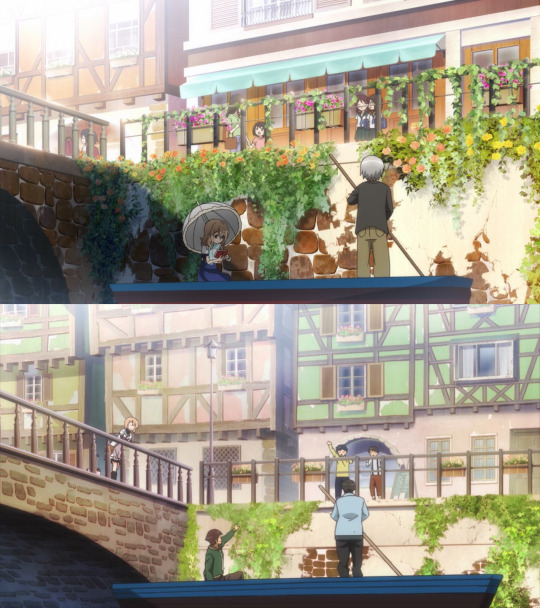
The episode opens with a shot of Aoyama Blue Mountain on a boat, which also appears in the beginning of season 1 episode 1. By the way before COVID you could totally ride a boat like this in Colmar. Just watch your head...

Yeah, this is under the bridge from season 2 ED. Filmed by me.
Anyway, I’m being sidetracked. What’s important is that this is the only shot where you could tell it’s morning, because of the angle of the shadow from the bridge. It is indeed morning, and we see Cocoa and Chino walking down to school. Seems the summer vacation is over and it’s already September? Cocoa, the self-described pikka-pika no onee-chan, tries to coerce Chino into committing to enter the same high school as her, while Chino is not sure about that. We’ve seen Chino being unsure about her future as recently as this season’s episode 1, and in regards to the high school choice the time for a decision is quickly approaching.
Soon we see Maya and Megu who are facing the same decision. Megu seems to have already decided on what Maya derisively calls the gokigenyo school. The greeting gokigenyo (ご機嫌よう) comes from the word “kigen” (機嫌) which means “mood”, and can be literally translated as “how do you do”. However the same word is also used as farewell, which often causes troubles for translators.

The concept of “gokigenyo school“ has been popularised by the light novel and anime series Maria watches over us (Marimite), which is also one of the most influential works of the yuri genre. This concept has also been parodied a number of times, for example in the excellent episode 5 of Flip Flappers.
Megu manages to convince Maya and Chino to come with her to a tour of this school, and we get a close-up of Maya hinting that she’s definitely hiding something.
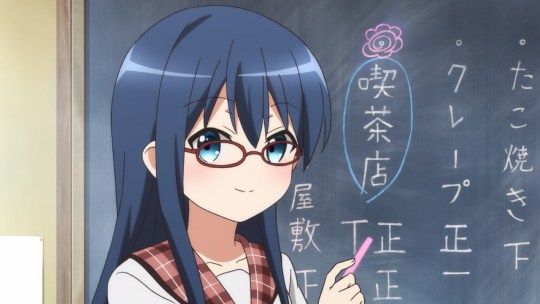
Meanwhile at Cocoa’s school, the class president declares the theme of the cultural festival being “cafe”, and puts Chiya and Cocoa in charge of it, because they work at a cafe. It seems that Chiya is considered to be more dependable than Cocoa by her classmates, since she got a higher rank. Nevertheless, it is Cocoa who mostly delivers the speech to fire up the other students.
Note the usage of Chinese tally marks to tally the votes. The five strokes comprising the character 正 (”truth”) equate 5 votes. This method is popular across East Asia, even in Korea where Chinese characters are no longer used.

Also I’ve seen a lot of people were confused by the inclusion of “sex museum” as one of the proposals, which is how 秘宝館 (hihokan) has been translated by the official subtitles. This word, which literally means “the hall of hidden treasures” has been used by various establishments of this type in post-war Japan, however only few of them remain open now. I think “sex museum” is a bad translation because, while technically correct, it breaks mimesis, or in simpler terms, immersion. The English translation is so blatantly inappropriate that it would never make it onto this blackboard, whereas the Japanese word is obscure and innocent-looking enough that it just might. A better translation would be “adult museum”, in fact that’s what the most well-known hihokan, Atami Hihokan uses for its English title.
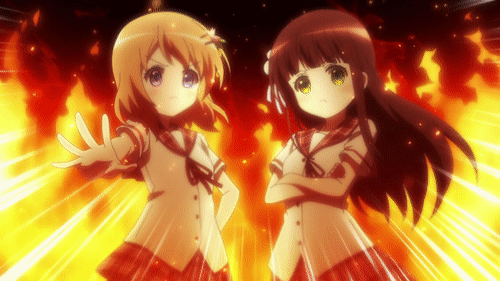
As proof of each other’s ability, Cocoa mentions Chiya’s triple tray wielding skill (お盆三刀流 obon santoryu) which has been demonstrated in season 2 episode 1. Chiya brings up Cocoa’s “basking in the sun” (日向ぼっこ hinatabokko) attitude which supposedly makes her popular among customers. This is a reference to season 2 episode 5 where Rize says Cocoa always either practices latte art or basks in the sun.

On the way back from school, we learn that Chiya is actually scared of the responsibilities placed on her, and her dream of becoming the president of Ama Usa An franchise (which has been mentioned in s2e1, s2e9 and maybe other episodes I forgot) might be ruined because of this. Cocoa consoles her, again showing her motherly side.
Back at Rabbit House, Cocoa explains how the upcoming festival will be exciting (wakuwaku) and fluffy/cuddly (mofumofu). This is one of several times Cocoa uses silly onomatopoeia to describe something in this episode (aforementioned pikkapika onee-chan and describing her school also as mofumofu in a latter scene). Interestingly, all of these lines are anime-original, and at this point seems like an intentional effort to make Cocoa speak in a more eccentric manner.
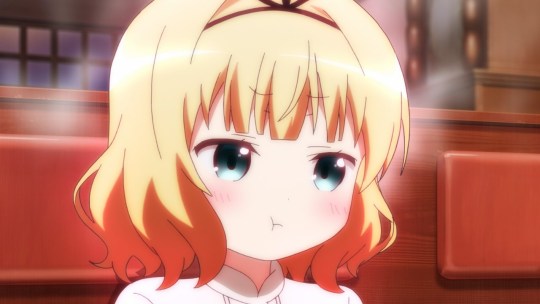
In the next scene Sharo becomes angry at Chiya for keeping secrets from her, and blows her cheeks, which makes her turn into a Fugu fish, according to Chiya. Fugu is famous in Japanese cuisine for being a highly poisonous but sought after delicacy, however in this case the comparison has to do with the tendency of a live fugu (as well as other pufferfish) to inflate its stomach, giving it an almost spherical appearance to deter predators.
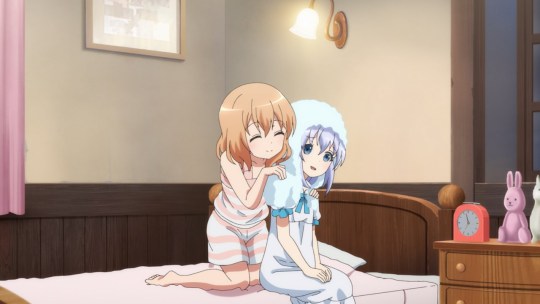
Next there’s another anime-original CocoChino scene where Chino asks Cocoa about what her school is like. This is my favorite part of the episode because it’s just so adorable. Like, even the fact that Cocoa is drying Chino’s hair with a towel after bath shows how close they became. The direction and the delivery of the dialogue is masterfully executed. Cocoa would be really hurt if Chino chooses any other school, and Chino knows that. But Chino can’t admit she’ll choose her next school because of Cocoa, at least not yet.
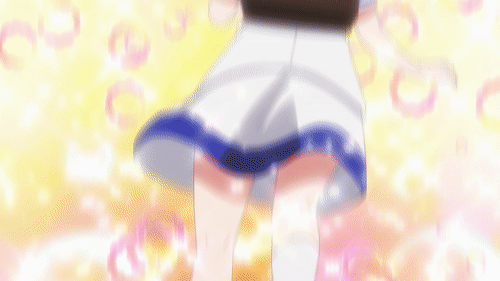
Now we move on to the main plot of the episode, which is Chimame visiting Rize and Sharo’s school. Like I said in the preview, this episode covers chapters 10 and 11 of the volume 5 of the manga, which in-universe occur at the same time. However while it fully covers (and has the same title as) chapter 10, only the first half of chapter 11 is included. So about 2/3 of the episode are dedicated to the story of chapter 10.

Chimame attend a speech by “OG” Mate Rin. OG in this case doesn’t mean “original gangsta”, but “old girl”, which is a Japanese term for female alumni of some school (there’s also OB for men). Chino recognizes Rin as the editor of Aoyama Blue Mountain, and I’m not sure if Maya and Megu ever met her, so they don’t. When Rin recalls a senior who turned her life around, Chino recalls her chance meeting with Cocoa. In particular the phrase deai ga taisetsu (”chance meetings are to be cherished”) sticks with her. On the other hand, Maya seems to be interested in the fact that Rin was recommended for scholarship. Interestingly in the manga, Maya slept through most of the speech.

The senior Rin was talking about was obviously Aoyama and we see that there’s actually a huge bounty placed on her. The currency sign consisting of combined letters G and U wasn’t seen before, with prices usually displayed in yen, but there was a Euro-like sign at an open market at the beginning of season 2 episode 1, which might be a shorthand way to write GU. Either way this currency must have a serious hyperinflation problem as the reward for finding Aoyama exceeds 10 billion GU. In countries affected by hyperinflation, a stable foreign currency is often used to perform economic transactions, which might explain why most of the prices are in yen.
But is there some significance to this exact number? Why, yes, 10/27 is Aoyama’s birthday! It is also the start of “reading week”, which actually lasts 2 weeks, until November 9.
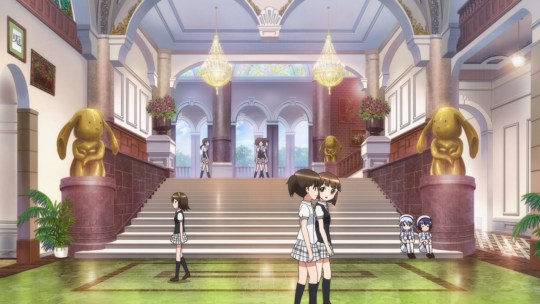
After the speech Megu gets separated from the rest of the group, and the other two also get lost in the vast campus of the school. As seen from the above interior shot of the school, it is also inexplicably rabbit-themed (or maybe just this particular hall is), with golden rabbit statues and also a picture on the left wall with the kanji for rabbit (兎).
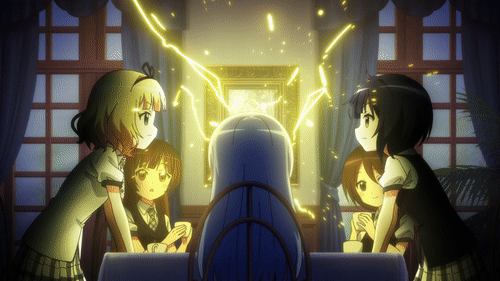
Through a series of misunderstandings Chimame end up infiltrating the school with Sharo and Rize providing uniforms for them to blend in. Despite having trouble to behave “ladylike” before, Maya naturally blends in once she treats it as a game, and even gets invited to a tea party. She makes a mistake though by mentioning moyashi (bean sprouts) which is considered a cheap and low-class food, but she’s saved by the fact that the rich girls don’t even know what that is, and Sharo explaining how to prepare it in a fancy way.
Eventually the groups meet each other and Maya reveals she has been recommended for scholarship due to her good grades. Perhaps she also treated her school grades as experience points to gain, as the title of the episode (and the manga chapter) ”The whole world is my experience points” seems to suggest. This is the idea behind a real concept of gamification, by the way.
There’s also a callback to the season 2 episode 8, where Maya asks Rize for advice while Chino and Megu are spying on her. It is worth to rewatch that scene, because it’s full of foreshadowing for this episode. Back then Maya thinks she’s the only one of the three to go to this school, but now she thinks there’s a good chance all three will still go to the same school. Chino doesn’t seem to feel this way though.

In the end we see Cocoa and Chiya joining the group, also wearing the elite school uniforms, which is briefly explained by them gathering supplies for the cultural festival. I guess the next episode will explain how they ended up there. In the manga even the fact that they have a cultural festival wasn’t revealed until this point. Also in the manga fukiya club president, Karede Yura, inexplicably appears for just one panel so that Cocoa and Chiya could thank her, without any lines. In the anime she appears just as (if not more) suddenly, however there’s some foreshadowing with her inviting Rize to a tournament earlier, and she gets quite a few speaking lines.
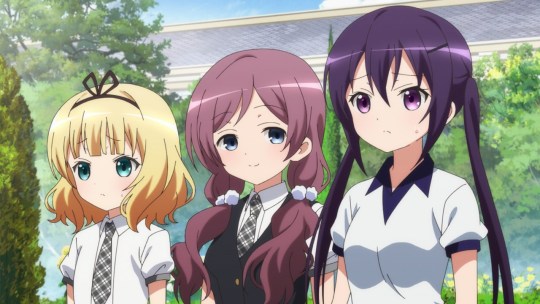
If you listen closely there’s a funny sound effect as she looks at Rize, and then at Sharo. I really liked her design since her first appearance in the manga, and Koi probably does too, as her role has greatly increased in the recent chapters. Consequently her single-panel background appearance has been expanded as well in this episode, she got her full name mentioned in the credits, and there’s even a Karede Yura character song included on the second BD volume (which includes this season’s episodes 3 and 4). All things considered, I fully expect Yura to appear in the episode 4 as well.
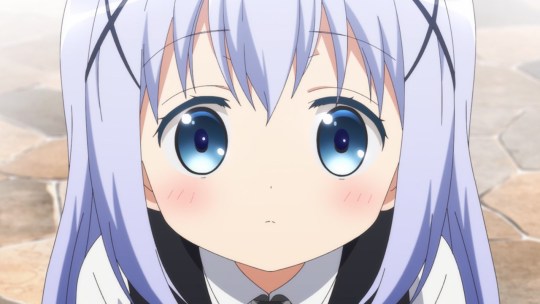
The episode ends with Chino looking at the sky with a worried expression. It just hit her that both Megu and Maya are going to a different school than she is expected to go to. As Megu and Maya have a clear path forward, Chino’s future has become even more uncertain, and she feels like the odd one out in the group. Now the part of the ending where Chino is suddenly alone makes sense:
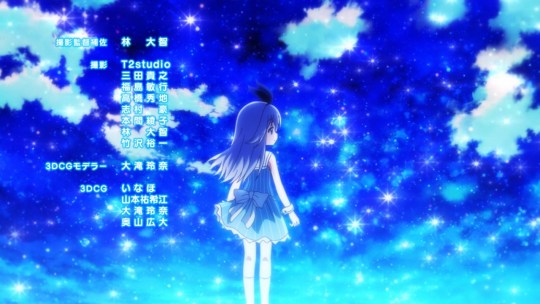
this is basically her imagining the future where Maya and Megu leave her. The coffee cup transition symbolises Chino waking up and seeing that MaMe are still her friends and aren’t going anywhere. We’ll see though...
This time it’s Megu doing latte art in the ending, and the picture is of Chino and Maya dancing. The weird thing is, Megu wasn’t even present at this scene, so how did she draw it in such detail?
Also another random fact I noticed: Chino’s Alice costume actually appeared in the opening of both season 1 and season 2. Here’s a comparison for reference:

Anyway, that was the third episode of Gochuumon wa usagi desu ka? BLOOM and I hope you enjoyed reading my review. See you next week... or so.
10 notes
·
View notes
Note
I notice that the ask thing says Hai, very cleaver my dear! Could you explain why people say Kun, San, Sama, ect. After they say someone's name? It's confused me for quite awhile -Higumom
That’s a great question Higumom!! ( ^ ω ^) Actually, the perfect topic to start with, so maybe this is Lesson 0?
LESSON 0: Japanese Honorific Titles
So, what’s the difference between –san, -kun, -sama, and all that? They’re all different endings that you can attach on to names, and occasionally other nouns of position, like doctors or lawyers or even bakers! They can be attached to first or last names! Whether you use a first or last name actually depends on your personal relationship with the person you’re speaking to or about.
-san (さん) is the standard politeness level, and is like a conventional Mr/Mrs/Miss. You can use this with just about anybody you meet once you learn their name without offending them. Along with this, you would typically use someone’s last name + san if you just met them, and until they tell you to call them by their first name. I add –san to everyone’s name when I talk to them <( ̄︶ ̄)>
太宰さん • だざい • Dazai-san
敦さん • あつしさん • Atsushi-san
皆さん• みんなさん• Minna-san • Everyone (polite)
お客さん• おきゃくさん• O-Kyaku-san • Mr. Customer
You can even add –san to the word for a shop in order to refer to the owner!
パンやさん• Panya-san • Mr. Baker (literally, Mr. Bread shop!)
本屋さん• ほんやさん• Honya-san • Mr. Bookshop owner (Mr. Bookshop!)
肉やさん• にくやさん• Nikuya-san • Mr. Butcher (Mr. Butcher shop!)
医者さん• いしゃさん• Isha-san • Mr. Doctor
Companies even use –san to refer to other companies, which is common on small maps in phonebooks and business cards. The ADA could be referred to as:
武装探偵社さん• ぶそうたんていしゃさん• Busoutanteisha-san • Mr. Armed Detective Agency! ヽ(・∀・)ノ
We can even use –san as a cute way to refer to an animal or inanimate object ^^
うさぎさん• Usagi-san • Mr. Bunny /(^ × ^)\
魚さん• さかなさん• Sakana-san • Mr. Fish or Mr. Fishy!
-sama (さま) is much more respectful than –san and is often used by people in the business and service sectors to refer to their customers. It’s often written on letters instead of –san, and you’ll see it often on Japanese receipts from just about any store! Of course, you can also use it to refer to someone you really respect, if their position relative to you warrants it. We also tend to use it to refer to various gods.
お客様• おきゃくさま • O-Kyaku-sama • Honored customer
皆さま• みんなさま• Everyone (honorific)
神さま• かみさま• Kami-sama • Honored God (シ_ _)シ
-kun (君• くん) is more informal and is usually used by people of more senior ranking to refer to people of more junior ranking, or among male colleages, or between male friends. You can certainly address male children with –kun attached to their name, or to close friends and family of any gender. But it can even be used by males of more senior status to younger female employees! This is why Dazai-san occasionally calls me Kyouka-kun ^^
鏡花君 • きょうかくん• Kyouka-kun
樋口君• ひぐちくん• Higuchi-kun <3
-chan (ちゃん) is also informal and shows that the speaker finds a person endearing or cute, and adds a sense of cuteness to the name (chan is cuter than san!). Of course it would be rude to use this with strangers. You can use it for babies, young girls, female friends, grandparents, and even young boys! It’s very common for mothers to shorten their son’s name and attach –chan or –kun to it as a nickname! It’ll eventually get dropped as the boy gets older, at least in public ^^ Atsushi-san always calls me this (≧◡≦)
鏡花ちゃん• きょうかちゃん • Kyouka-chan
あくちゃん• Aku-chan or あっくん• Akkun (Akutagawa)
I’ll bet Gin-san used to refer to Akutagawa-san like that ^^
It’s also used to refer to cute things and animals!!
猫ちゃん• ねこちゃん• Neko-chan
-tan (たん) An even more cute version of –chan!! It’s like baby talk (widdle instead of little) and mascots often have it added onto their names. Only used with young children in a family or among very close friends or family to add cuteness as a nickname. Actually, all sorts of different endings can be made up to create a cute nickname (*≧ω≦*)
-shachou (社長• しゃちょう) Company president. In the working environment, it is very common to use your boss’s title when referring to them, or other appropriate titles to refer to other workers. You can also use the title as a standalone as well, without attaching it to a name:
福沢社長• ふくざわしゃちょう• Fukuzawa-shachou •Company President Fukuzawa
部長• ぶちょう• Buchou • Department Manager
課長• かちょう• Kachou • Section Chief
会長• かいちょう• Kaichou • President/Chairman
-sensei (先生せんせい) Used to refer to people who have authority in a particular field of knowledge, like a teacher, doctor, artists, musicians, accomplished writers, martial arts leader, etc. It can also be used as a standalone title without the person’s name! Kunikida-san would have been called this by the students in his math classes!
國木田先生• くにきだせんせい• Kunikida-sensei • Prof. Kunikida
-hakase (博士• はかせ) Does this one sound familiar to anyone? I’ve heard it used by Ash in referring to his Pokemon professor in the new Alola anime ^^ Similar to sensei, but this should be used if the teacher has a doctorate’s degree to indicate much higher learning! Like Sensei, it can be used as a standalone title. Literally means Professor, whereas Sensei can be translated as ‘professor’ or ‘teacher’.
-senpai (先輩• せんぱい) Senior. Used to refer to somebody of senior status (more experience) in a school, workplace, or club. It can be used as a title on its own or attached to a name.
kouhai (後輩• こうはい) Junior, the opposite of senior, but you don’t actually use this one as a form of address!! A junior would simply be addressed with their name + kun or some appropriate suffix!
tono (殿• との) Historical title used to refer to a feudal lord or samurai! But mainly used in official documents and certificates now. It becomes ‘-dono’ when attached to a name.
殿• との • Tono • Lord
信長殿• のぶながどの • Nobunaga-dono • Lord Nobunaga
-ue (上• うえ) This literally means above, and gives a high level of respect. It’s not really used anymore, but was commonly used to refer to one’s own mother, father, or sister when speaking to them. I don’t think Chuuya-san uses this term to refer to Kouyou-san…
父上•ちちうえ• chichi-ue • Honored Father
母上• ははうえ• haha-ue • Honored Mother
姉上•あねうえ• ane-ue • Honored Older Sister
~~~~~~~~~~~~~~~~~~
You rarely use honorific titles to refer to your own self, unless you want to be seen as arrogant…
Oh, one final note, is that Japanese people rarely say the word ‘you’ when speaking to someone! Unless, of course you’re deliberately being rude, or you don’t know the person’s name and absolutely have to refer to them in some way. Normally, you use the person’s name plus appropriate suffix. So if I was talking to Chuuya-san and wanted to ask him what he ate for lunch, I could say, “Chuuya-san wa nani o tabemashita ka?”, which literally translates to “What did Chuuya-san eat?”, which in English sounds kinda cute when you’re speaking directly to that person. A more natural English translation would be, “What did you eat?”
Wow, Higuchi-san, this took a while! Great question!! I’ll probably get Lesson 1 out tomorrow ^^
30 notes
·
View notes
Text
Sailor Moon 90s Dub Names
So some of the name changes in the Sailor Moon DiC dub really baffle me. (Keep in mind I did not watch Sailor Moon as a kid, I was vaguely aware of it's existence, but I never watched a single episode until I was a senor in high school, so I started with the sub and have no nostalgic ties to the DiC/Cloverway dub. However I did read the Mixx version of the manga so I was exposed to the changed names there and later I heard so much about the dub I went and watched a handful of episode out of curiosity)
Lets start with the title character
Usagi – DiC name: Serena – Mixx name: Bunny
Okay Usagi is weird because she actually has two dub names, obviously Serena in the anime, but a lot of people don't seem to know in the first American printing of the manga she was actually called Bunny. Now I don't know which came out first in America the manga or the anime, and I'm too lazy to look it up, but I'm going to guess the manga did just because of this reason. Changing Usagi to Bunny actually isn't too stupid, Anime hadn't quite taken over America yet so a lot of people still got rattled by super foreign names. As I get older I do start to understand localization was the thing in the 90s. Since Bunny is literally what Usagi means I didn't find this too stupid. Plus it shows why Usagi is obsessed with rabbits.
Serena though? I don't think Serena fits the character AT ALL! Not only does it simply sound like it doesn't fit the character, but look at the name meaning: "clear, tranquil, serene" none of those things could be used to describe Usagi. And yes, I know the same could be said for Serenity but Serenity was Usagi's PAST LIFE, not who she is now. I've gone off on what I think of keeping her Princess name the same a few times on this blog so I won't even go there in this post.
Now, in fairness, this one I actually was given an explanation for at a con, at a panel with John Stocker (one of the men who originally helped write the dub script) I asked why they didn't just use the name “Bunny” and he said it had to do with syllables, the mouth movement for “U-sa-gi” matched the mouth movement for “Ser-ren-na” better than “Bun-ny” But since everyone but Rei and Chibiusa use honorifics, I'm calling bullshit on this excuse. (Victoria was also in the running for a dub name, which fits Usagi even less than Serena, but at least the syllable excuse would work for that one.)
Mamoru Chiba– DiC and Mixx name: Darien Shields
I have to admit, I find it hilarious that they do try to capture the name meaning here. Mamoru literally means “Protect”, and so I laugh that they just literally make his last name “Shields”. To be honest, while I find it a kind of boring name, I don't think it contrasts him too terribly much because I kind of find Mamoru to be a boring character. (sorry Mamo) Like I could totally see him as a Darien, that's fine, it's the 90s, whatever. But again, like with Princess Serena, do we really need to make his past life's name “Prince Darien” Seriously? Along with it being lazy. Darien does not sound royal to me, particularly not fantasy/mythology status royal. And Endymion is a great name with a great story behind it! Like why did we have to cut out that mythological tie? In Greek Mythology an astronomer (or shepherd depending on variations) name Endymion fell in love with the goddess of the moon and was cursed by Zeus, that's a great detail that totally gets erased.
Chibiusa (Usagi Small Lady Serenity) – DiC and Mixx name: Rini (No official princess name to my knowledge)
This one totally disproves the syllables excuse because there's no way in hell anyone thought “Chi-Bi-Us-Sa” was the same mouth movement as “Ri-ni” But I suppose this one makes sense since Chibiusa is a nickname for Usagi, Rini is a nickname for Serena. I suppose the name fits her well enough, though I do think in the Black Moon Arc the enemy kept referring to her as “Small Lady” instead of “Rabbit”. Like, okay, whatever, her name isn't Usagi, Rabbit wouldn't make sense. But then at one point the enemies try to trick her by appearing as Neo-Queen Serenity and she calls her Small Lady, and Chibs is all like “My mommy would NEVER call me Small Lady, you're not really her” like, no bitch, that's your name! It's not a title, Usagi was just that corny when she named you. DiC DON'T CUT USAGI'S CORNINESS!
Ami Mizuno – DiC and Mixx name: Amy Anderson – Cloverway: Amy Mizuno
Okay Ami, Rei, Mina, and Michiru I can't criticize too much because they're just the American translation of the Japanese names so I don't really mind, they're spelled different, but so what? But Ami baffles me because she's the only one of the girls with a different last name. Like, why? Seriously, why? Even Usagi's last name stays the same and that's arguably much more Japanese sounding than Mizuno. I mean, don't get me wrong, Anderson's my last name, it's a good last name, but why is she the only one with an American last name? But what makes it even better is Cloverway then changes it back to Mizuno and no one ever mentions it again.
Just for fun I'm also going to point out that “Blue” was in the running for a dub name for her and I think that's the funniest shit ever. “What should we name this character?” “IDK, what's her color scheme?” “Blue.” “Good enough!” I'd actually like to thank the dubbers for sticking with Amy.
Rei Hino – DiC and Mixx name: Raye Hino
Can't say much about Rei. It's spelled weird, I would have gone with Rae, but whatever. Dana was apparently in the running for her, again, glad they decided against changing it.
Makoto Kino – DiC and Mixx name: Lita Kino
I actually think Lita fits Makoto pretty well. Almost just as well as Mako-chan. Sara was also in the running which I also don't think would have been a too terribly bad choice, Lita's less generic though.
Minako Aino – DiC and Mixx name: Mina Aino
Again, same name, just a different variation of it. Artemis even calls her Mina as a nickname in the original so whateves. Carrie was in the running for her which would have been a fucking awful fit, so I'm glad they stayed with Mina.
Haruka – Cloverway name: Amara – Mixx name: Haruka but also sometime Alex
WARNING: Raging hate boner rant coming up!!!!
This is the name that actually got me to write this whole thing!
Out of all the name changes Haruka's pisses me off the most. It's SUCH a bad fit. I don't hate the name Amara itself, I actually think it's kind of pretty, but it does NOT go with this character! You give the most gender androgynous character one of the most feminine names? It doesn't fit. It sounds weird, it doesn't mesh with her personality, it seems weird every time they call her that!
And what's most baffling to me, THEY STILL PLAY THE 'IS SHE A GUY?' GAME! When Usagi and Minako meet her, they still pad after her thinking she's a guy. Haruka is a name that while typically more common for women, is gender neutral. Amara is definitely not. How can you not hear the name “Amara” and not instantly think, “Oh, shit, that's a chick”
Now the Mixx Manga did something weird, because they introduced the character as Alex Haruka, but only for the panel she was introduced in, then she was Haruka exclusively until one panel in the Dream Arc when she's called Alex again, but that's it. So...great proof reading there guys. Honestly Alex should have been her name in the Cloverway dub. Sure it doesn't fit her as well as Haruka does, but it fits a hell of a lot more than Amara. And more importantly it's one of the most gender neutral names ever.
Also her first draft name was Corinn, can't decide if that's better or worse than Amara. Seriourly dub, why didn't you take Alex? Or another gender neutral name? Riley? Sam? Ash? Jess? Skyler? (BTW I totally just googled “gender neutral American names” to give these examples and had to laugh cuz Skyler would have been the best, corniest pun ever)
Michiru – Cloverway name: Michelle
Again this one I have no qualms with because I've seen plenty of animes where the name Michiru and Michelle are used interchangeably depending on the dubber and the VA's accent. Again, same name different language.
Nerissa was supposed to be her dub name, which is fucking stupid, I'm glad they stayed with Michelle.
Setsuna – Cloverway name: Trista
Okay, so this is actually the reason I know all the names that were in the running, because I actually had to look up Setsuna's dub name, not cuz I hadn't seen any episodes of the dub with Setsuna in them, but cuz the name Trista to me is really forgettable. I don't know why, it's just a super forgettable name, Setsuna, more than any of the others, even more than Haruka really, I can't see having any name other than Setsuna (other than Plu of course) though that brings me to a little side tangent. Because Chibiusa doesn't call her “Plu” in the dub, she calls her “Luna P” which, no, I'm sorry, no, just no! Luna P is Chibi's toy, not Pluto, Luna P doesn't even remotely make sense as a nickname for Pluto. Yes she does talk with Pluto using Luna P (which I think is called “the Luna Sphere” in the dub) but that doesn't mean we get to degrade a badass character such as Pluto down to the status of a stuffed floating cat's head. Bad dubbers! Bad!
Also, her almost name was Celia, which again, no, sorry. Setsuna is Setsuna.
Hotaru – Cloverway name: Hotaru – Mixx name: Hotaru, but also Jenny just a couple of times.
Last but not least, my favorite character, Hotaru. Now obviously I can't get mad here because they didn't change her name, but I am really confused as to why. Seriously I still can't figure out why they changed ever other name that sounded too Japanese but this one character. Unlike Rei or Mina, this isn't even one that can be an American name too. Hotaru definitely sounds Japanese. Why does just this one character get to keep her super Japanese sounding name? Absolutely no idea. Like Haruka the Mixx seemed to have wanted to rename her but decided against it and not been very good at telling everyone they decided against it because the name “Jenny” pops up a few times in the Manga, but only after Haruka, Michiru, and Setsuna adopt her so take that as you will. I'm glad they didn't rename her, but if they would have chose to I don't think Jenny would have been a god awful choice
#sailor moon#sailor moon dub#i wrote this at like 3 am#my mind obsesses over weird stuff at 3 am#I have no idea why
3 notes
·
View notes